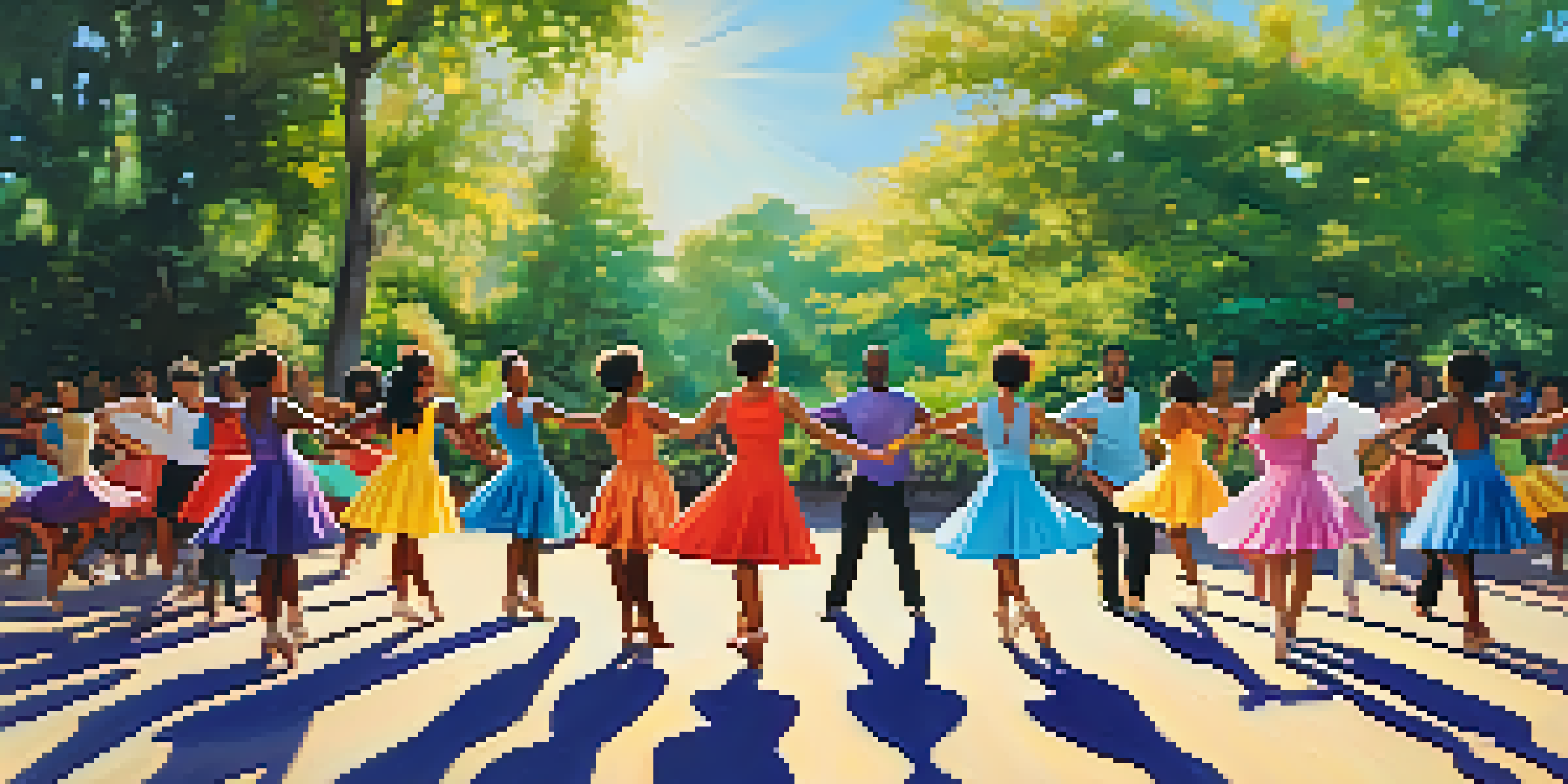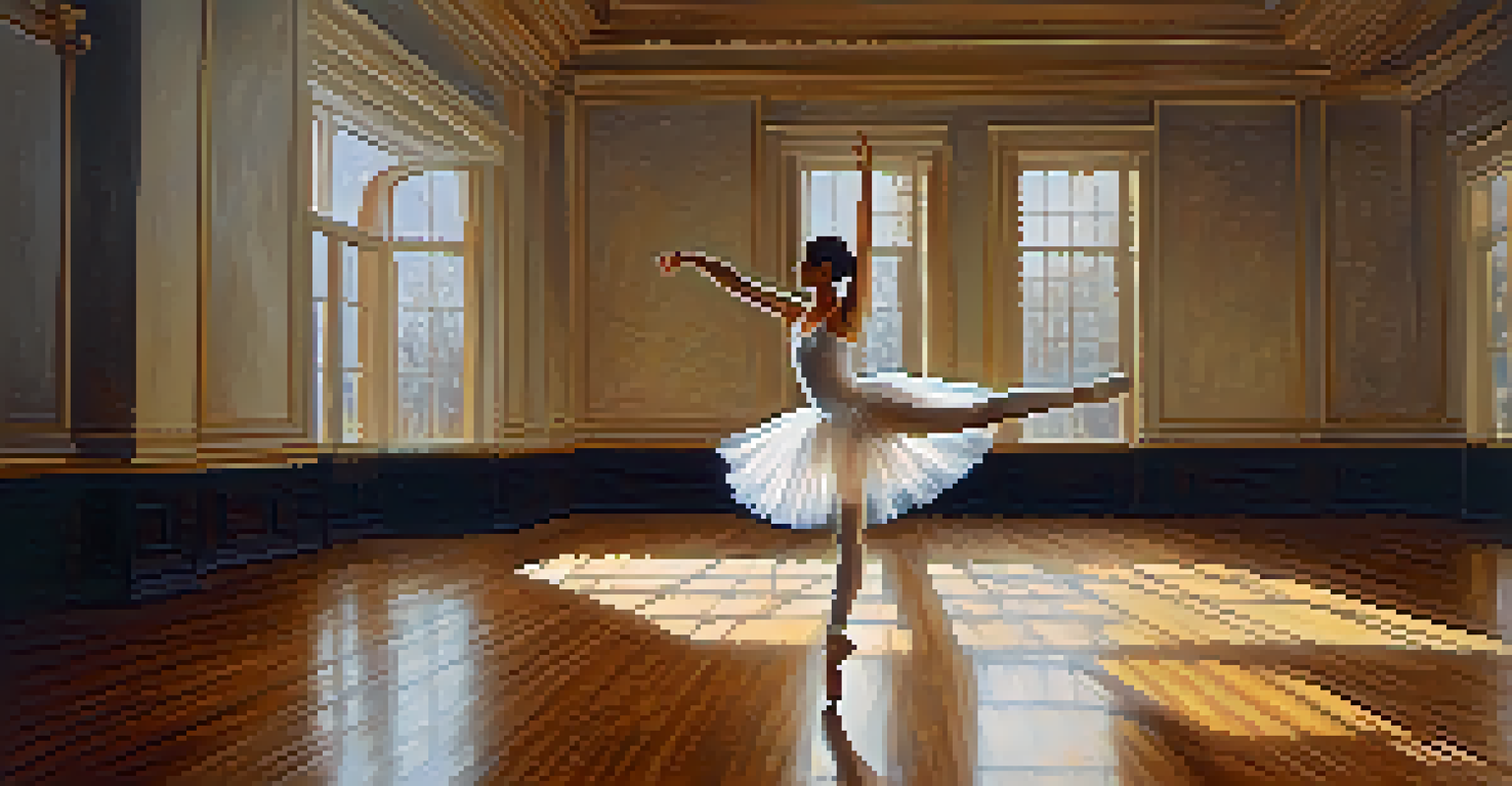Dance as a Means of Stress Relief and Emotional Release

The Therapeutic Power of Dance in Stress Relief
Dance has long been celebrated as a form of artistic expression, but its therapeutic qualities often go unnoticed. Engaging in dance can trigger the release of endorphins, those feel-good hormones that help combat stress. Whether it's a spontaneous dance break or a structured class, moving your body can instantly uplift your mood.
Dance is the joy of movement and the heart of life.
In fact, many studies have shown that physical activity, including dance, reduces levels of cortisol, the hormone associated with stress. This means that when you dance, you’re not just shaking off the day’s worries, but actively improving your mental well-being. It’s a win-win situation where you get to groove while your stress levels drop.
Moreover, dance allows for creativity and personal expression, enabling individuals to channel their feelings into movement. This unique combination of physical activity and emotional expression makes dance a powerful tool for combating stress.
How Dance Connects Mind and Body
The act of dancing engages both mind and body, creating a holistic experience. As you focus on your movements, you naturally shift your attention away from daily stressors. This mindfulness aspect of dance helps ground you in the present moment, fostering a sense of peace.

Additionally, dancing often involves rhythm and coordination, which require concentration. This mental engagement means you can't dwell on worries or anxieties while you're focused on your next step or beat. Think of it as a mini-vacation for your mind, where you can escape from stress.
Dance Reduces Stress and Anxiety
Engaging in dance releases endorphins and lowers cortisol levels, actively improving your mental well-being.
By synchronizing your movements with music, you also stimulate your brain's pleasure centers. This connection between mind and body not only enhances your mood but also encourages relaxation, ultimately leading to a greater sense of well-being.
Expressing Emotions Through Dance
Dance serves as a powerful medium for emotional release. When words fail to capture what we're feeling, movement can fill that gap. Whether it’s joy, sadness, or anger, expressing these emotions through dance can be incredibly cathartic.
Dance enables you to find yourself and lose yourself at the same time.
For example, consider a dancer performing a slow, graceful ballet piece to convey sadness. The movements, the music, and the visual storytelling all work together to express deep emotions that might be difficult to articulate. This ability to express oneself can provide much-needed relief from pent-up feelings.
Furthermore, the community aspect of dance can amplify this emotional release. Participating in group classes or dance circles can foster connections with others, creating a supportive environment where everyone can share their feelings through movement.
The Role of Music in Dance and Emotional Release
Music is often the heartbeat of dance, playing a crucial role in how we experience movement and emotion. Different genres of music can evoke various feelings, from the upbeat tempo of pop to the soothing melodies of classical. When combined with dance, this musical backdrop amplifies emotional expression and helps release tension.
Listening to your favorite songs while dancing can create a joyful atmosphere that encourages you to let go of stress. The rhythm of the music often guides your movements, allowing you to express yourself freely. As you dance, you sync your body to the beat, creating a harmonious flow that lifts your spirits.
Mind-Body Connection in Dance
Dancing fosters mindfulness by focusing your attention on movements, providing a temporary escape from stressors.
Moreover, music has the unique ability to trigger memories and emotions. A particular song might remind you of a happy moment, prompting you to dance with joy and gratitude. This powerful connection between music and emotion can enhance the stress-relieving benefits of dance.
Finding Your Dance Style for Stress Relief
One of the beautiful aspects of dance is its diversity; there’s a style for everyone! From salsa to hip-hop, ballet to contemporary, exploring different styles can help you find what resonates with you most. Choosing a style you enjoy can make the experience more fulfilling and less of a chore.
For instance, if you love high-energy environments, you might thrive in a Zumba class. On the other hand, if you prefer something more introspective, contemporary dance might be your go-to. The key is to find a form that not only fits your personality but also feels good to your body.
Remember, the goal isn’t to be perfect but to enjoy the process. Allowing yourself to experience dance in a way that feels authentic can enhance its benefits for stress relief and emotional expression.
Incorporating Dance into Your Daily Routine
Integrating dance into your daily life doesn’t require a dance studio or a formal class; it can happen anywhere! Consider setting aside time at home to put on your favorite playlist and dance freely. Even a few minutes of movement can do wonders for your mood and stress levels.
You can also look for local dance classes or workshops in your community. Joining a group can add a social element to your dance practice, making it a fun, shared experience. Plus, the motivation from fellow dancers can encourage you to stick with it.
Emotional Expression Through Movement
Dance serves as a powerful outlet for expressing emotions, facilitating relief and connection within a supportive community.
Lastly, don’t forget about dance breaks throughout the day. Whether you're working from home or at the office, taking a moment to dance can refresh your mind and relieve tension. These mini breaks can help you return to your tasks feeling recharged and focused.
The Lasting Benefits of Dance for Mental Health
The benefits of dance extend far beyond just the momentary relief from stress. Regularly engaging in dance can lead to improved mental health, increased self-esteem, and a greater sense of community. Over time, these positive changes can contribute to a more resilient mindset.
Many individuals find that dance helps them manage anxiety and depression. The combination of physical activity, emotional expression, and social connection creates a strong support system for mental well-being. This makes dance a valuable tool in one’s mental health toolkit.

Ultimately, embracing dance as a form of stress relief and emotional release can lead to a happier, healthier life. So why not put on your favorite song and let loose? You might just find that dance is the perfect antidote to life’s stresses.